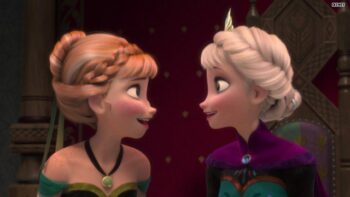
A baby is on my breast, I am balancing a book on my knee, and the two year-old is watching Frozen for the fifteenth time because she’s enchanted and I am on maternity leave in a polar vortex. It is only January. By March, after I’ve returned to work and we’re no longer dealing with cabin fever, she’ll have watched it in the ballpark of forty times. Now that it is August, the toddler insists on wearing her Frozen ski hat with ensembles of Elsa shirts, multiple tutus, and high tops.
Some of you are swearing to yourself that no daughter of yours will wear that much princess merchandise, nor will she be permitted screen time until the age of three. You think this way because you either have convinced yourself that parenting is tantamount to martyrdom or you don’t have children. I was once in the latter category so I get it. I also thought that the contents of my bookcases would prevent the lure of the Disney princess.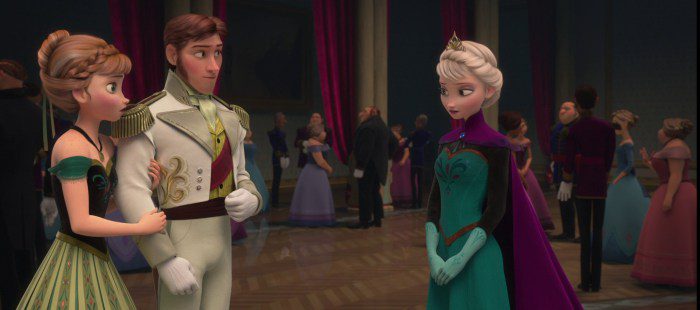 As it is, Jane Austen and Judith Butler only frame the icy fantasy that plays again and again in our living room.
As it is, Jane Austen and Judith Butler only frame the icy fantasy that plays again and again in our living room.
Weathering the fourth trimester in the Chicago winter left me feeling trapped. Frozen gave me 102 precious minutes to dive into a book everyday that the newborn, the toddler, and I were holed up in our two-bedroom apartment. My leisure reading practice has been one of literary self-help since I was a girl. A. S. Byatt raised me as a second-wave feminist, David Lodge assuaged Catholic guilt, and Call the Midwife consoled me in a time of grief. Henry Rollins taught me how to travel alone, On the Road instilled the importance of pilgrimage, and Portrait of the Artist As A Young Man instructed me how to recognize a formative moment. I thank The Rachel Papers for avoiding narcissists. Canonical novels with female protagonists were always the most terrifying. If there was one thing I learned from Tess Durbeyfield, Lily Bart, and Constance Chatterly, it was not to get trapped. I’ve never put down a book because it confronted me with hard truths. I read Caitlin Moran’s chapters on childbirth and abortion in How To Be A Woman while in labor with my first child. I escaped from shivering contractions and a numb left leg but not from impending motherhood.
The long days of quiet domestic rage were not everyday but they were hard. One of those difficult mornings, I looked up from my comrades in arms—from Anya Ulinich or Sarah Waters or Jenny Offill or Elena Ferrante—and encountered freedom in frosted fjords. Like Brave before it, Frozen passes the Bechdel test by transforming the conflict between women from one of violent sexual jealousy (Snow White, Cinderella, Sleeping Beauty) to one of magical accidents. The film continues the trend of revising the Disney princess, a movement begun with Pocahantas and advanced with films like Mulan and Tangled. 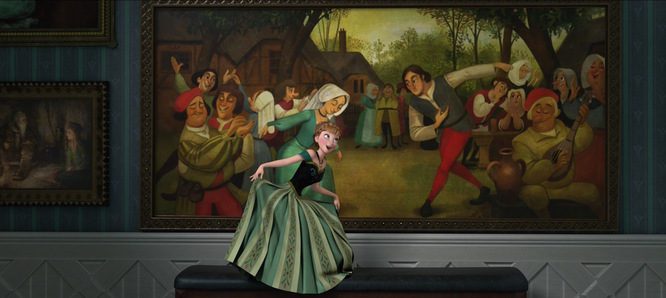 With Frozen, though, the achievement is not about creating a heroine of color—it is so not that—or crafting a protagonist who simply does things by herself. This film celebrates the death of the Disney marriage plot.
With Frozen, though, the achievement is not about creating a heroine of color—it is so not that—or crafting a protagonist who simply does things by herself. This film celebrates the death of the Disney marriage plot.
The feminist potential in the film exists in its depiction of failure. Not Elsa’s failure to keep hidden her frosty magic and become an exemplary queen, but Anna’s failure to enact true love according to the rigid rules of the traditional princess genre. It is an imaginary world where kind hunters gift pigs’ hearts to wicked queens so that love-at-first-sight can be seen as romantic rather than a wrong swipe right.
No one knows this story better than Anna. We can’t be sure how she spent her childhood behind the castle gates, but in all likelihood she immersed herself in VHS tapes from the pre-Mulan Disney vault. While she sings the celebratory, “For the first time in forever!” she muses that she might “meet the one,” and we see her place herself in a number of poses in famous paintings, always as the object of desire. What becomes clear is that Anna is practiced in appealing to the Disney gaze. Like my toddler does, she goes from make-believe to trying it out for real. Only in her case, she’s not holding up her glass saying “cheers!” and delighting in the fact that her table partner clinks her cup. Rather, she attempts to forcefully enact a fictive script.
Anna meets Prince Hans of the Southern Isles by crashing into him at the end of a song-and-dance sequence. This is the princely deus ex machina, the fabricated mechanical god of the princess tale who swoops in to rescue an underage woman from eventual spinsterhood. Hans and Anna become engaged within a matter of hours. No one else thinks this is a good idea, which must mean it’s really bad seeing that the inhabitants of Arendelle still think it’s a good idea to live in an ice oligarchy full of inherited wealth and rule. Elsa forbids the marriage and the mountain man, Christoph, freaks out. “You’re telling me you got engaged to someone you just met?” he exclaims as they ride on his reindeer-drawn sled. He points out to Anna that she knows nothing about her fiancé. Nonetheless, Anna places all her hope in their love, which is put to the ultimate test after Elsa repeats a childhood accident and blasts her sister, this time hitting her heart. According to mystical trolls, who problematically figure as the magical minorities of this Disney film, only an act of true love can counteract a frozen heart or else Anna will turn to ice. Our heroine hurries back to Arendelle to find Hans so that he can kiss her. He refuses. It turns out that the foreign aristocrat has staged a mutiny, raising an army to capture Elsa. His plan was to kill Anna, get close to Elsa, and then take over the kingdom. The women were an expendable entry into kingly power. He leaves an increasingly frigid Anna to die alone—no, really—and goes after Elsa with sword in hand. Instead of re-evaluating her idea of true love, Anna runs in search of another man she has just met, Christoph.
According to mystical trolls, who problematically figure as the magical minorities of this Disney film, only an act of true love can counteract a frozen heart or else Anna will turn to ice. Our heroine hurries back to Arendelle to find Hans so that he can kiss her. He refuses. It turns out that the foreign aristocrat has staged a mutiny, raising an army to capture Elsa. His plan was to kill Anna, get close to Elsa, and then take over the kingdom. The women were an expendable entry into kingly power. He leaves an increasingly frigid Anna to die alone—no, really—and goes after Elsa with sword in hand. Instead of re-evaluating her idea of true love, Anna runs in search of another man she has just met, Christoph.
Anna cannot imagine a future other than so-called true love because she lives and nearly dies by the plot points of previous Disney films. Her perspective is so colored by the tropes and norms of the apple-pumpkin-spindle script that she doesn’t understand that her major problem is not finding the one, but of rooting out foreign usurpers. Yes, she is a princess, and, yes, she exists in a magical kingdom, but the rules have changed. They haven’t reverted to the Old World justice of Brothers Grimm, but they do reflect a revision oriented towards realism and this is what our heroine completely misses. It’s like going into Deadwood and acting according to the rules of Annie Get Your Gun. And for that reason, Anna is sorta fucked.
Frozen is a study in what happens when imagination is constrained to a single narrative arc: she is desired, she falls into a perilous situation, she suffers, she has faith, and she is saved by God, a prince, or a gentleman vampire. She often exists in the passive voice. Sometimes she is prayerful or mops up or goes to prom. This narrative instructs us that it is better for a young woman to allow miracles and suffering to determine the course of her life rather than her own intellect and will. I’ve always found this story more silly than offensive in genre fiction but its equivalent in the here and now gives me pause. Throughout my life I have witnessed women measure their relationships by what they are willing to give up in order to maintain blind faith in a future that could be but often isn’t. 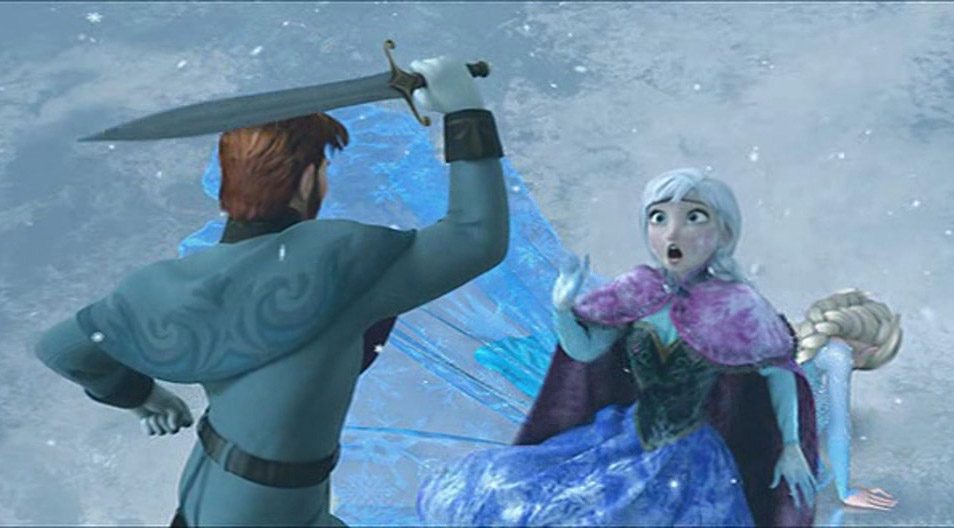 That is the tragedy of this script, which comes uncomfortably close to crossing over from the fictive and to the social. Cinderella’s patient waiting is no different than St. Agnes’s torture or Bella Swan’s pining, all of which reap rewards. There is no warning in these stories not to get trapped.
That is the tragedy of this script, which comes uncomfortably close to crossing over from the fictive and to the social. Cinderella’s patient waiting is no different than St. Agnes’s torture or Bella Swan’s pining, all of which reap rewards. There is no warning in these stories not to get trapped.
At the climax of Frozen, a frosty Anna is running towards Christoph for a restorative kiss and Hans is raising his sword over Elsa to execute her. Anna reverses course and blocks the blow between the sword and her sister. She turns into a statue of ice, breaking the sword into two. Moments later, she turns back to flesh. It is her own act of true love that saves herself, her sister, and her city-kingdom. Anna’s act is selfless, but she breaks free of the martyr syndrome in her turn from princess to hero.
The story of Anna’s failure is rare. The inability to trigger romance through magical thinking usually points to a lack of faith, a lack of purity, or a lack of the correct space-time continuum, as in Disney’s Enchanted. But Anna has done everything right. She has studied the princess genre for years, adhered to its implicit instruction manual wholeheartedly, and still does not succeed. This failure does not reveal deficiency in the heroine. Instead we’re met with the collapse of a central cultural conceit. Anna’s act of will not only displaces the prince but also it dispenses with the need for the prince ex machina and all of the trappings of the genre that go with him.
The space between play-acting and attempting actual action is no so far, something that Anna and my children remind me of everyday. The baby is just beginning to wave and to attempt the “h” sound that will eventually become “hi.” The toddler is at an age of mimicking our speech, our activities, and even our emotional affect, something that she does with movies and bedtime stories as well. What we do, and what stories do, are instructing our little girl how to be. She tells us she is “going shopping,” “going to work,” and “going to the gym,” piling on grocery and tote bags as she looks for keys and heads to the door. And, despite my best efforts not to, I have instructed her on how to be a woman by passing on the terrible habit of using “sorry” instead of “excuse me” or “oops” or “watch where you’re going!” 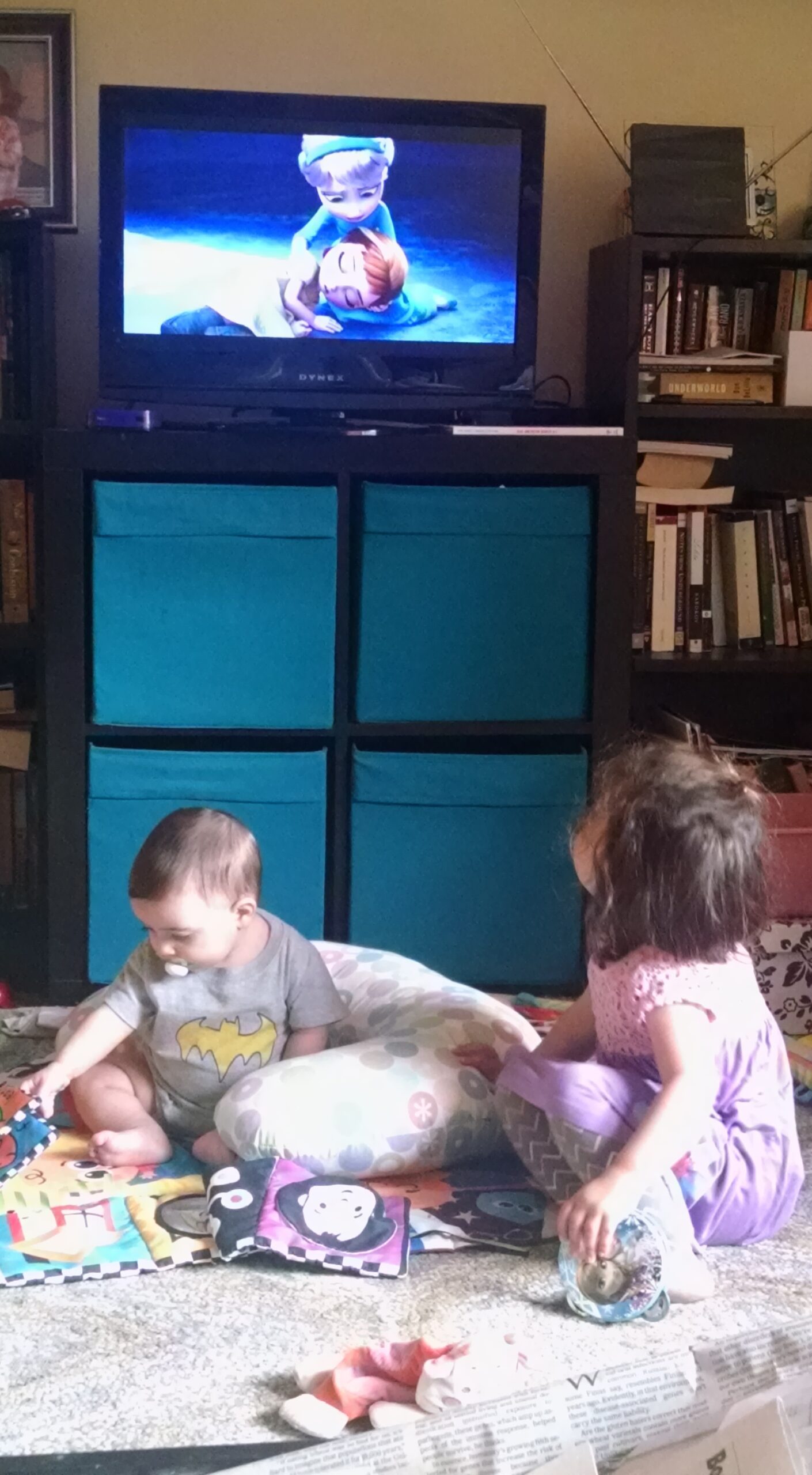 Cultural norms, anticipated actions, and social scripts are going to impact both of my daughters. My impulse is not to censor stories, but to encourage their playful improvisation on narrative so that if someday they get stuck in a genre, they can let it go.
Cultural norms, anticipated actions, and social scripts are going to impact both of my daughters. My impulse is not to censor stories, but to encourage their playful improvisation on narrative so that if someday they get stuck in a genre, they can let it go.
The story of Frozen began as a way for me to keep my sanity, but as winter melted, the baby began to sleep more, and the toddler experienced a language explosion, it has become a way to have a lot of fun together. She asks me to turn off All Things Considered and we badly power ballad “Let it Go” on our way home. She tells me that Olaf is smaller than the giant snowman. I consider the type of parliamentary system that might operate in an historic Nordic city-state. Sometimes we discourse on the problem of justice in Arendelle. She says seriously, “Anna pushed Hans in the water!” I respond, “Shouldn’t that be a capital crime?”
One day when she uttered the verboten “Princess Anna and Princess Elsa,” I turned around at a stoplight and hissed, “Really, and what do Anna and Elsa do all day? What sort of work do they do? How do they earn a living?” She attempted an eye roll. “They don’t go to work, Mama,” she replied matter-of-factly. “They go to school. They go to astronaut school in Africa.” Obviously. I laugh at her, as well as at myself. I’m relieved that her imagination isn’t yet constrained, whether by romantic narrative arcs or the work-week. These moments reassure me that I’m not trapped because she’s not.
***
Image credits: featured image, image #2, image #3, image #4, image #5, image #6 provided by author.




